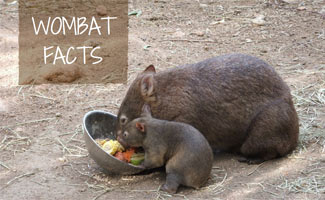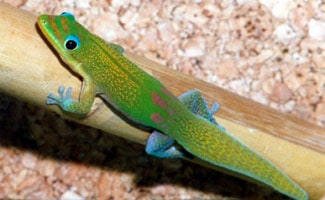The Ultimate Wombat Facts Guide
 The wombat is a marsupial of mystery for those who do not live in its natural habitat. There are three species of this burrowing rodent and below we will take a look at each of these species to discover everything you ever wanted to know about this three-foot long herbivore including their metabolism and biggest threats in the wild.
The wombat is a marsupial of mystery for those who do not live in its natural habitat. There are three species of this burrowing rodent and below we will take a look at each of these species to discover everything you ever wanted to know about this three-foot long herbivore including their metabolism and biggest threats in the wild.
What Does the Wombat Look Like?
Wombats can be varying shades of brown, grey or black and have a short and thick bristle-like fur. The wombat does not have an undercoat and most people describe the feeling of this marsupial’s fur as horse-like. While there are three different species of wombat all three measure in at around 3.4 feet long. The length of the wombat may not change between species but the weight of each species varies considerably from forty to eighty pounds.
The wombat is quite a chubby creature and it tends to waddle as it walks on all four legs. The legs of the wombat are short and thick and for the most part these creatures move very slowly. When threatened however, this burrower can reach speeds of as high as twenty five miles an hour! Although they can move quickly when necessary, the wombat is not able to maintain these speeds for extended periods of time. Most people recognize the wombat by its large koala like nose; however, not every species of wombat has this type of nose. Being a marsupial, the wombat has a pouch but their pouch is backwards facing. The backward facing pouch of the wombat is an adaptation that allows for the female to secure her young while burrowing without filling her pouch with dirt.
The Scientific Classification of the Wombat
Infraclass Marsupialia
The infraclass marsupialia defines a number of mammals that give birth to young that are very underdeveloped. These young travel to the female marsupials pouch where it remains until it is more fully developed. Within the pouch these tiny offspring feed from the mother’s teats. The presence of a pouch is not the only thing that separates marsupials from placental mammals; marsupials also have a unique reproductive system. Female’s two lateral vaginas both have uteri but share one external opening. Additionally, females have a third canal which is used to give birth. Males of the species have a penis with two prongs which serves the sole purpose of inseminating females. Marsupials lack a complex placenta since they give birth to such underdeveloped young, this is why non-marsupials are referred to as placentalia.
Order Diprotodontia
The order diprotodontia contains one hundred and twenty mammals, all of which are marsupials. Most diprotodonts are herbivores and are found in Australasia. Researchers believe that the extinct diprotodonts, thylacoleonids were the only carnivorous diprotodonts to ever have lived. All diprotodonts are characterized by two distinct features – two large incisors on the lower jaw and the second and third digits of the feet are fused together up to the base of the claws. This fused digit characteristic is referred to as syndactyly. There are three suborders of diprotodontia: vombatiformes, phalangeriformes and macropodiformes. The suborder vombatiformes includes koalas and wombats. The suborder phalangeriformes includes possums and cuscuses. The suborder macropodiformes includes kangaroos, wallabies and rat-kangaroos.
Suborder Vombatidae
The suborder vombatidae is made up of six genera: vombatus, lasiorhinus, rhizophascolomus, phascolonus, warendja and ramasayia. Only two of these genera are still extant: vombatus and lasiorhinus. Within the genera vombatus there is only one living species, the vombatus ursinus. The Lasiorhinus has two living species, the lasiorhinus latifrons and Lasiorhinus krefftii.
Vombatus Genera
The vombatus genus is also referred to as the common wombat, the bare-nosed wombat or the coarse-haired wombat. This is the average person’s image of what a wombat looks like. This wombat species grows to an average of 3.25 feet long and weighs in at around 57 lbs. Like other wombat species, the common wombat is a solidly built marsupial that walks low to the ground but it is easily distinguished by its bald nose. This wombat species is native to Tasmania and Flinders Island and southern and eastern Australia and is not as common to mainland Australia. The common wombat is a solitary species and is extremely territorial. Within its territory range, this wombat builds a series of tunnels underground and prefers to hunt during the night when the weather is cooler. As an herbivorous species the common wombat feeds on grass and plant material. The reproductive habits of the common wombat are not conducive to a thriving species since the female can breed only once every two years. Each successful breeding to a female wombat results in a single joey that is born after just twenty to thirty days gestation. After being born the small underdeveloped joey crawls in to its mother’s pouch where it develops for an additional five months. The joey is not fully weaned from its mother’s milk until it is around a year old and it will not become independent until it is a year and a half old.
There are three subspecies of the common wombat: V. ursinus hirsutus, V. ursinus tasmaniensis and V. ursinus ursinus. V. ursinus hirsutus is the originally discovered common wombat species and is native to the Australian mainland. V. ursinus tasmaniensis is smaller than the hirsutus subspecies and is found throughout Tasmania. V. ursinus ursinus is the most threatened of the common wombat subspecies and currently has an estimated population of around four thousand. This vulnerable subspecies is now only found on Flinders Island north of Tasmania.
Lasiorhinus Genera
The lasiorhinus genus of wombat contains two living species, the Northern hairy nosed wombat and the Southern hairy nosed wombat. Both of these hairy nosed wombat species are native to Australia. The Northern hairy nosed wombat is a critically endangered species and in the present day it can only be found within a 3 km² range of the Epping Forest National Park in Queensland. Before their critical conservation status however, the Northern hairy nosed wombat could also be found in Victoria and New South Wales. The Southern hairy nosed wombat can be found in arid locations in Australia from New South Wales southwest to the South Australia and West Australia border.
Northern Hairy Nosed Wombat
The Northern hairy nosed wombat is also recognized as a Yaminon. This wombat species was last noted as having just over one hundred individuals left, thirty of which were females capable of breeding. These marsupials tend to be just over a foot high and 3.3 feet long. The females of the species are larger than the males which weigh in at an average of 88 lbs. Where the common wombat is known for its slow breeding rates, the reproductive cycles of these slightly larger wombats are faster. One average a female of the species is capable of giving birth to two joeys every three years. The hairy nose of this wombat species not only helps it to stand apart from the common wombat species, but it also helps it to sniff out food sources. Like other wombat species, the Northern hairy nosed wombat hunts at night and with such poor eyesight the keen sense of smell of this creature is crucial to its survival. These nocturnal hunters feed on grass and roots. When they are not hunting, the Northern hairy nosed wombat can be found in a system of underground burrows which they dig using their nearly two-inch long claws. The Northern hairy nosed wombat gives birth to a single joey, most often during the rainy season which will climb in to its mother’s backwards facing pouch where it will stay until it is approximately 8 months.
The Northern hairy nosed wombat is so endangered that within its small natural habitat in Epping Forest, a six and a half-foot high fence has been built to surround it. The predator proof fence has protected 25 km² of the wombat’s territory since 2000. Since 2008 a second population of these threatened wombats has been established in the Richard Underwood Nature Refuge at Yarran Downs in Southern Queensland.
Southern Hairy Nosed Wombat
The Southern hairy nosed wombat is the smallest of all three living wombat species. Recognized as the state animal of South Australia, this small wombat species lives in the scrub from Nullarbor Plain to the border of New South Wales. Of all wombat species, the Southern hairy nosed wombat is fragile and its young often do not survive dry seasons due to their small size and high temperatures. This small species measures in at thirty to thirty six inches long and can weigh anywhere from 42 to 70 lbs. The silky fur of this marsupial ranges from light tan to deep grey and the characteristic hairy nose is flat and almost like that of a pig in appearance. The southern hairy nosed wombat feeds on perennial grasses and leaves. This species is known for its ability to recycle water and is recorded as the herbivorous mammal with the lowest recorded water turnover. These mammals are known for living in communal burrows, as many as ten individuals are noted as living in burrows connected by underground tunnels. Although they live in communities, these wombats are still territorial and males will attack males of other warren systems to defend their territory.
The female southern hairy nosed wombat gives birth to a single young after mating and a twenty two day gestation period. The young joey climbs in to its mother’s pouch and stays there until it is around six months old. After leaving the pouch the joey continues to feed from its mother until it is around a year old. As soon as the joey leaves the pouch, the female is once again able to reproduce. The southern hairy nosed wombat does not reach its full size until it is three years old!
Patrick: The Largest and Oldest Wombat
In this short video you’ll get to meet Patrick, the largest and oldest living Wombat in the world. Weight in at just under 40 kilograms, he’s one big ball of cute overload.
https://www.youtube.com/watch?v=elqhEWWRjDM
The Metabolism of the Wombat
Researchers have found that the metabolism of the wombat is particularly intriguing because it is measured to be only 64% of the marsupial average. In addition, the level of thyroid hormones in the wombat is the lowest of any mammal to ever be recorded. The foraging wombat has been shown to consume enough food to provide 2.8 times the amount of maintenance energy needed by the wombat. The average wombat takes between one to two weeks to complete digestion of what it consumes; this process is designed to help the creatures to survive in particularly dry conditions in which food can become scarce. The colon of the wombat is uniquely designed with two sections. The front section of the colon works to ferment vegetation that is consumed and the lower section of the colon serves to reabsorb water. Rather than excreting all water as urine, the wombat recycles urea to the colon to conserve water in its naturally arid environment. The ability to recycle water means that the wombat’s feces are extremely dry and distinguishable from other wildlife.
Hunting and Being Hunted
The wombat is a herbivore but that does not mean that they will not attack if they feel threatened or if they are establishing or protecting their territory. Most often these creatures prefer to avoid confrontation and dive in to their burrows for safety but there are circumstances where humans find themselves in wombat confrontations. The most effective and safest way to avoid being injured in a wombat confrontation is to climb a nearby tree until the animal leaves the area. Despite being herbivorous, wombats can be aggressive and inflict serious bites as well as wounds using their long sharp claws. Wombats may knock humans over if they feel threatened by using their rounded body as something of a bowling ball. Another concern for humans confronted by angry wombats is the potential for contracting illness or bacterial infections from bite or scratch wounds.
Wombat’s are not exempt from being hunted and have a number of natural predators. In addition to humans who treat the more common wombat species as pests, wombat’s face large predators such as dingoes and Tasmanian devils. Both of these predators are determined predators but the wombat puts up a unique fight for its life. Unlike the common defense of biting back, the wombat relies upon its large backend to save its life. When threatened by predators, wombats will dive in to their burrows head first, leaving the predator face to face with its tough rear end that is made of cartilage. The predator is left with no real substance to grip on the wombat and instead they will be completely blocked from attacking. In cases where the burrow is large enough for a predator to slide their head over the back of the wombat, it will often have its skull completely crushed by the back legs of the wombat as it kicks upward.
The Biggest Threats to Wild Wombat Populations
Not all wombat species are threatened by extinction but all species are threatened by a variety of factors. For the endangered species, certainly small populations are a concern, but for all species predation, disease and competition for food are also a concern. Predation is such a concern for the already threatened wombat populations that officials had to construct a predation protection fence to protect the already small populations. Disease is also a significant concern for all wombat species, most particularly sarcoptic mange. Sarcoptic mange is developed as the result of a burrowing mite that causes intense itching and secondary infection, eventually animals with sarcoptic mange that are not treated can succumb to infection. This illness is extremely contagious and as a result it travels quickly among wombat populations. Competition for food is also a concern for wombat populations because cattle and sheep overgraze the natural habitat of these creatures leaving them with little to eat. While the wombat is able to sustain itself on very little food, if current rates of competition continue wombat populations will continue to dwindle in all extant species.
The Importance of the Wombat
The wombat may be restricted to the Australian continent but that does not reduce their importance to the ecosystem. Wombats naturally prefer to live in arid and semi-arid ecosystems that rely upon the burrowing of the wombat to maintain soil. As the wombats burrow and turn over soil they encourage the growth of new plant life by allowing moisture to penetrate in to the soil. Without the wombat’s natural aerating of the soil, many local plant species would not survive and consequently, many native herbivorous species would be eliminated as well.
Have you ever seen a wombat?



